 |
VANISHING FAIRS |
| << OLD HOSPITALS AND ALMSHOUSES |
| THE DISAPPEARANCE OF OLD DOCUMENTS >> |
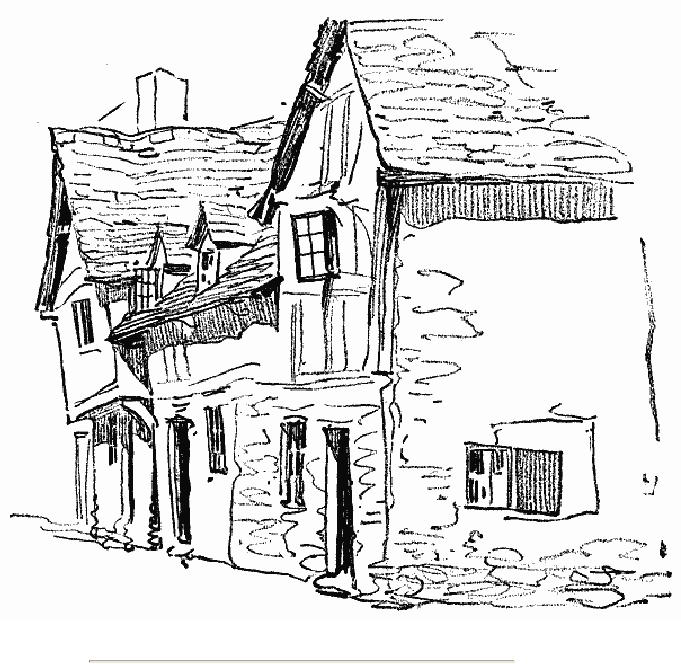
Cottages
at Evesham
CHAPTER
XVI
VANISHING
FAIRS
The
"oldest inhabitants" of our
villages can remember many
changes in the social
conditions
of country life. They can
remember the hard time of
the Crimean war
when
bread was two shillings and
eightpence a gallon, when
food and work
were
both
scarce, and starvation wages
were doled out. They
can remember the
"machine
riots," and tumultuous scenes at
election times, and scores of
interesting
facts,
if only you can get them to
talk and tell you
their recollections. The
changed
condition
of education puzzles them.
They can most of them read,
and perhaps
write
a little, but they prefer to
make their mark and get you to attest it
with the
formula,
"the mark of J----N." Their
schooling was soon over. When
they were
nine
years of age they were
ploughboys, and had a rough
time with a
cantankerous
ploughman
who often used to ply
his whip on his lad or on
his horses quite
indiscriminately.
They have seen many changes,
and do not always "hold
with"
modern
notions; and one of the greatest
changes they have seen is in
the fairs. They
are
not what they were.
Some, indeed, maintain some of
their usefulness, but
most
of
them have degenerated into a
form of mild Saturnalia, if
not into a scandal and a
nuisance;
and for that reason have
been suppressed.
Formerly
quite small villages had
their fairs. If you look at
an old almanac you
will
see
a list of fair-days with the
names of the villages which,
when the appointed
days
come round, cannot now boast
of the presence of a single
stall or merry-go-
round.
The day of the fair was
nearly always on or near the
festival of the
patron
saint
to whom the church of that
village is dedicated. There is, of
course, a reason
for
this. The word "fair" is
derived from the Latin
word feria,
which means a
festival,
the parish feast day. On the
festival of the patron saint
of a village church
crowds
of neighbours from adjoining
villages would flock to the
place, the
inhabitants
of which used to keep open
house, and entertain all
their relations and
friends
who came from a distance.
They used to make booths and
tents with boughs
of
trees near the church, and celebrated
the festival with much
thanksgiving and
prayer.
By degrees they began to
forget their prayers and remembered
only the
feasting;
country people flocked from
far and near; the pedlars and
hawkers came
to
find a market for their
wares. Their stalls began to
multiply, and thus the germ
of
a
fair was formed.
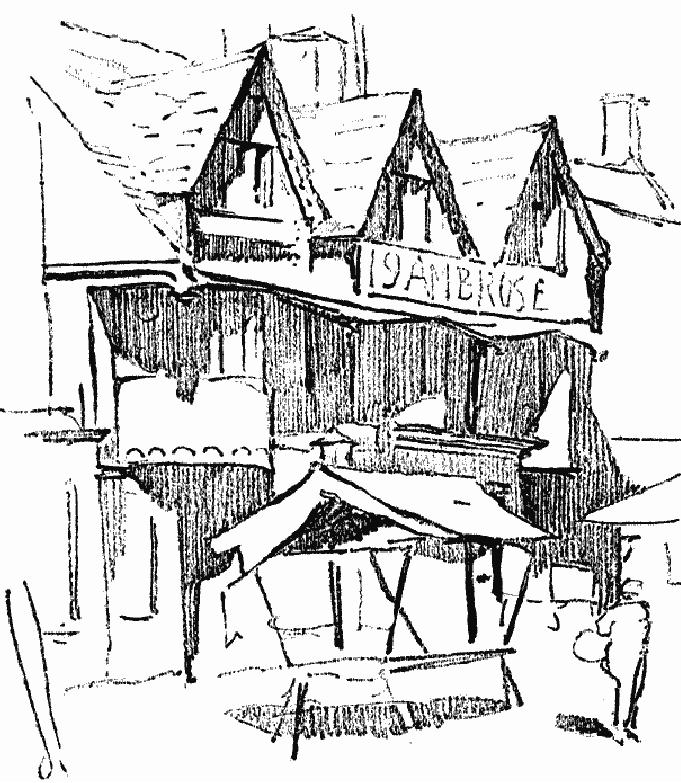
Stalls
at Banbury Fair
In
such primitive fairs the
traders paid no toll or rent for
their stalls, but by
degrees
the
right of granting permission to
hold a fair was vested in the
King, who for
various
considerations bestowed this favour on
nobles, merchant guilds, bishops,
or
monasteries.
Great profits arose from
these gatherings. The traders had to
pay toll
on
all the goods which
they brought to the fair, in
addition to the payment
of
stallage
or rent for the ground on
which they displayed their
merchandise, and also
a
charge on all the goods they
sold. Moreover, the
trades-folk of the town
were
obliged
to close their shops during
the days of the fair, and to
bring their goods to
the
fair, so that the toll-owner
might gain good profit
withal.
We
can imagine, or try to
imagine, the roads and
streets leading to the
market-place
thronged
with traders and chapmen, the
sellers of ribbons and cakes,
minstrels and
morris-dancers,
smock-frocked peasants and sombre-clad
monks and friars. Then
a
horn
was sounded, and the lord of
the manor, or the bishop's
bailiff, or the mayor
of
the
town proclaimed the fair;
and then the cries of the traders,
the music of the
minstrels,
the jingling of the bells of
the morris-dancers, filled
the air and added
animation
to the spectacle.
There
is a curious old gateway, opposite
the fair-ground at Smithfield,
which has
just
recently narrowly escaped
destruction, and very nearly
became part of the
vanished
glories of England. Happily
the donations of the public
poured in so well
that
the building was saved. This
Smithfield gateway dates back to
the middle of
the
thirteenth century, the
entrance to the Priory of
St. Bartholomew, founded
by
Rahere,
the court jester of Henry I,
a century earlier. Every one
knows the story of
the
building of this Priory, and
has followed its
extraordinary vicissitudes,
the
destruction
of its nave at the
dissolution of monasteries, the
establishment of a
fringe
factory in the Lady Chapel,
and the splendid and
continuous work of
restoration
which has been going on
during the last forty years.
We are thankful
that
this choir of St.
Bartholomew's Church should
have been preserved for
future
generations
as an example of the earliest and
most important ecclesiastical
buildings
in London. But we are
concerned now with this
gateway, the beauty
of
which
is partially concealed by the
neighbouring shops and dwellings
that surround
it,
as a poor and vulgar frame
may disfigure some matchless gem of
artistic
painting.
Its old stones know
more about fairs than do
most things. It shall tell
its
own
history. You can still admire
the work of the Early
English builders, the
receding
orders with exquisite mouldings
and dog-tooth ornament--the
hall-mark
of
the early Gothic artists. It
looks upon the Smithfield
market, and how many
strange
scenes of London history has
this gateway witnessed!
Under its arch
possibly
stood London's first chronicler,
Fitzstephen, the monk, when
he saw the
famous
horse fairs that took place in
Smithfield every Friday,
which he described
so
graphically. Thither flocked earls,
barons, knights, and citizens to look on
or
buy.
The monk admired the
nags with their sleek and
shining coats,
smoothly
ambling
along, the young blood
colts not yet accustomed to
the bridle, the
horses
for
burden, strong and stout-limbed, and
the valuable chargers of elegant
shape and
noble
height, with nimbly moving
ears, erect necks, and plump
haunches. He waxes
eloquent
over the races, the
expert jockeys, the eager
horses, the shouting
crowds.
"The
riders, inspired with the
love of praise and the hope of
victory, clap spurs to
their
flying horses, lashing them
with their whips, and
inciting them by
their
shouts";
so wrote the worthy monk
Fitzstephen. He evidently loved a
horse-race,
but
he need not have given us
the startling information,
"their chief aim is
to
prevent
a competitor getting before
them." That surely would be
obvious even to a
monk.
He also examined the goods of
the peasants, the implements
of husbandry,
swine
with their long sides,
cows with distended udders,
Corpora
magna boum,
lanigerumque
pecus, mares
fitted for the plough or
cart, some with frolicsome
colts
running
by their sides. A very
animated scene, which must
have delighted the
young
eyes of the stone arch in
the days of its youth, as it
did the heart of the
monk.
Still
gayer scenes the old
gate has witnessed.
Smithfield was the principal
spot in
London
for jousts, tournaments, and
military exercises, and many a grand
display
of
knightly arms has taken place
before this priory gate. "In
1357 great and royal
jousts
were then holden in
Smithfield; there being present
the Kings of England,
France,
and Scotland, with many
other nobles and great estates of
divers lands,"
writes
Stow. Gay must have
been the scene in the
forty-eighth year of Edward
III,
when
Dame Alice Perrers, the King's mistress,
as Lady of the Sun, rode
from the
Tower
of London to Smithfield accompanied by
many lords and ladies, every
lady
leading
a lord by his horse-bridle, and
there began a great joust
which endured
seven
days after. The lists were
set in the great open space
with tiers of seats
around,
a great central canopy for
the Queen of Beauty, the
royal party, and
divers
tents
and pavilions for the
contending knights and esquires. It was a
grand
spectacle,
adorned with all the pomp
and magnificence of medieval
chivalry.
Froissart
describes with consummate
detail the jousts in the
fourteenth year of
Richard
II, before a grand company,
when sixty coursers gaily
apparelled for the
jousts
issued from the Tower of
London ridden by esquires of
honour, and then
sixty
ladies of honour mounted on palfreys,
each lady leading a knight
with a chain
of
gold, with a great number of
trumpets and other instruments of
music with them.
On
arriving at Smithfield the ladies
dismounted, the esquires led
the coursers which
the
knights mounted, and after
their helmets were set on
their heads
proclamation
was
made by the heralds, the
jousts began, "to the great
pleasure of the beholders."
But
it was not all pomp and
pageantry. Many and deadly
were the fights fought
in
front
of the old gate, when men
lost their lives or were
borne from the
field
mortally
wounded, or contended for
honour and life against unjust
accusers. That
must
have been a sorry scene in
1446, when a rascally
servant, John David,
accused
his
master, William Catur, of treason,
and had to face the wager of
battle in
Smithfield.
The master was well beloved, and
inconsiderate friends plied
him with
wine
so that he was not in a condition to
fight, and was slain by his
servant. But
Stow
reminds us that the
prosperity of the wicked is
frail. Not long after
David was
hanged
at Tyburn for felony, and
the chronicler concludes:
"Let such false
accusers
note
this for example, and look
for no better end without
speedy repentance." He
omits
to draw any moral from
the intemperance of the master and
the danger of
drunkenness.
But
let this suffice for
the jousts in Smithfield.
The old gateway heard on
one
occasion
strange noises in the church,
Archbishop Boniface raging
with oaths not
to
be recited, and sounds of strife and
shrieks and angry cries. This
foreigner,
Archbishop
of Canterbury, had dared to come with
his armed retainers
from
Provence
to hold a visitation of the
priory. The canons received
him with solemn
pomp,
but respectfully declined to be
visited by him, as they had
their own proper
visitor,
a learned man, the Bishop of
London, and did not care
for another
inspector.
Boniface lost his temper,
struck the sub-prior,
saying, "Indeed, doth
it
become
you English traitors so to
answer me?" He tore in
pieces the rich cope
of
the
sub-prior; the canons rushed to
their brother's rescue and
knocked the
Archbishop
down; but his men
fell upon the canons and
beat them and trod
them
under
foot. The old gateway was
shocked and grieved to see the
reverend canons
running
beneath the arch bloody and
miry, rent and torn,
carrying their complaint
to
the
Bishop and then to the King
at Westminster. After which
there was much
contention,
and the whole city rose and
would have torn the
Archbishop into small
pieces,
shouting, "Where is this
ruffian? that cruel smiter!"
and much else that
must
have
frightened and astonished Master Boniface
and made him wish that he
had
never
set foot in England, but
stayed quietly in peaceful
Provence.
But
this gateway loved to look
upon the great fair that
took place on the Feast of
St.
Bartholomew.
This was granted to Rahere the
Prior and to the canons and
continued
for seven centuries, until
the abuses of modern days
destroyed its
character
and ended its career. The
scene of the actual fair was
within the priory
gates
in the churchyard, and there
during the three days of its
continuance stood the
booths
and standings of the
clothiers and drapers of London and of
all England, of
pewterers,
and leather-sellers, and without in the
open space before the priory
were
tents
and booths and a noisy crowd of traders,
pleasure-seekers, friars, jesters,
tumblers,
and stilt-walkers. This open space was
just outside the turreted
north wall
of
the city, and was girt by
tall elms, and near it was a sheet of
water whereon the
London
boys loved to skate when
the frost came. It was the
city playground, and
the
city gallows were placed
there before they were
removed to Tyburn. This
dread
implement
of punishment stood under the
elms where Cow Lane
now runs: and one
fair
day brave William Wallace
was dragged there in chains at
the tails of horses,
bruised
and bleeding, and foully done to death
after the cruel fashion of
the age. All
this
must have aged the
heart of the old gateway,
and especially the sad sight
of the
countless
burials that took place in
the year of the Plague,
1349, when fifty
thousand
were interred in the burial
ground of the Carthusians, and
few dared to
attend
the fair for fear of
the pestilence.
Other
terrible things the gateway
saw: the burning of
heretics. Not infrequently
did
these
fires of persecution rage.
One of the first of these
martyrs was John Bedley,
a
tailor,
burnt in Smithfield in 1410. In
Fox's Book
of Martyrs you
can see a woodcut
of
the burning of Anne Ascue
and others, showing a view of
the Priory and the
crowd
of spectators who watched the
poor lady die. Not
many days afterwards
the
fair-folk
assembled, while the ground
was still black with her
ashes, and dogs
danced
and women tumbled and the
devil jeered in the miracle
play on the spot
where
martyrs died.
We
should need a volume to
describe all the sights of
this wondrous fair, the
church
crowded
with worshippers, the halt
and sick praying for
healing, the
churchyard
full
of traders, the sheriff proclaiming
new laws, the young
men bowling at
ninepins,
pedlars shouting their wares,
players performing the
miracle play on a
movable
stage, bands of pipers, lowing
oxen, neighing horses, and
bleating sheep.
It
was a merry sight that
medieval Bartholomew
Fair.
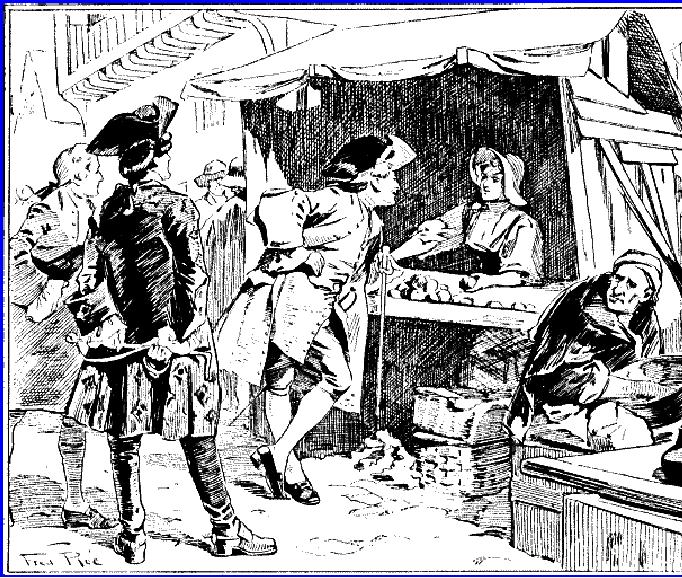
An
Old English Fair
We
still have Cloth Fair, a
street so named, with a remarkable group
of timber
houses
with over-sailing storeys and
picturesque gables. It is a very dark
and
narrow
thoroughfare, and in spite of many
changes it remains a veritable
"bit" of
old
London, as it was in the
seventeenth century. These houses
have sprung up
where
in olden days the merchants'
booths stood for the sale of
cloth. It was one of
the
great annual markets of the
nation, the chief cloth
fair in England that had
no
rival.
Hither came the officials of
the Merchant Tailors'
Company bearing a
silver
yard
measure, to try the measures of
the clothiers and drapers to
see if they were
correct.
And so each year the great
fair went on, and priors and
canons lived and
died
and were buried in the
church or beneath the grass of
the churchyard. But
at
length
the days of the Priory were
numbered, and it changed masters. The
old
gateway
wept to see the cowled
Black Canons depart when Henry VIII
dissolved
the
monastery; its heart nearly
broke when it heard the sounds of
axes and
hammers,
crowbars and saws, at work on
the fabric of the church
pulling down the
grand
nave, and it scowled at the
new owner, Sir Richard
Rich, a prosperous
political
adventurer, who bought the
whole estate for £1064 11s.
3d., and made a
good
bargain.
The
monks, a colony of Black
Friars, came in again with
Queen Mary, but
they
were
driven out again when
Elizabeth reigned, and Lord
Rich again resumed
possession
of the estate, which passed
to his heirs, the Earls of
Warwick and
Holland.
Each Sunday, however, the
old gate welcomed devout
worshippers on
their
way to the church, the
choir having been converted
into the parish church
of
the
district, and was not sorry to
see in Charles's day a brick
tower rising at the
west
end.
In
spite of the changes of ownership
the fair went on increasing
with the increase of
the
city. But the scene
has changed. In the time of
James I the last elm tree
had
gone,
and rows of houses, fair and comely
buildings, had sprung up.
The old
muddy
plain had been drained and
paved, and the traders and
pleasure-seekers
could
no longer dread the wading
through a sea of mud. We
should like to follow
the
fair through the centuries,
and see the sights and
shows. The puppet shows
were
always
attractive, and the wild
beasts, the first animal
ever exhibited being "a
large
and
beautiful young camel from
Grand Cairo in Egypt. This
creature is twenty-
three
years old, his head and neck
like those of a deer." One
Flockton during the
last
half of the eighteenth
century was the prince of
puppet showmen, and he
called
his
puppets the Italian Fantocinni. He
made his figures work in a
most lifelike style.
He
was a conjurer too, and the
inventor of a wonderful clock
which showed nine
hundred
figures at work upon a
variety of trades. "Punch and
Judy" always
attracted
crowds, and we notice the
handbills of Mr. Robinson, conjurer to
the
Queen,
and of Mr. Lane, who
sings:
It
will make you to laugh, it will drive
away gloom,
To
see how the eggs will
dance round the
room;
And
from another egg a bird
there will fly,
Which
makes all the company
all for to cry,
etc.
The
booths for actors were a
notable feature of the fair.
We read of Fielding's
booth
at
the George Inn, of the
performance of the Beggar's
Opera in 1728,
of
Penkethman's
theatrical booth when
Wat
Taylor and Jack Straw was acted, of
the
new
opera called The
Generous Free Mason or the Constant
Lady, of
Jephthah's
Rash
Vow, and
countless other plays that
saw the light at Bartholomew
Fair. The
audience
included not only the
usual frequenters of fairs,
but even royal
visitors,
noblemen,
and great ladies flocked to the booths
for amusement, and during
its
continuance
the playhouses of London
were closed.
I
must not omit to mention
the other attractions, the
fireproof lady, Madam
Giradelli,
who put melted lead in her
mouth, passed red-hot iron
over her body,
thrust
her arm into fire, and
washed her hands in boiling oil; Mr.
Simon Paap, the
Dutch
dwarf, twenty-eight inches
high; bear-dancing, the
learned pig, the
"beautiful
spotted
negro boy," peep-shows, Wombell's
royal menagerie, the learned
cats, and
a
female child with two
perfect heads.
But
it is time to ring down the
curtain. The last days of
the fair were not
edifying.
Scenes
of riot and debauch, of violence and lawlessness
disgraced the assembly.
Its
usefulness
as a gathering for trade purposes
had passed away. It became a
nuisance
and
a disgrace to London. In older days
the Lord Mayor used to
ride in his grand
coach
to our old gateway, and
there proclaim it with a great
flourish of trumpets. In
1850
his worship walked quietly
to the accustomed place, and found that
there was
no
fair to proclaim, and five
years later the formality
was entirely dispensed
with,
and
silence reigned over the
historic ground over which
century after century
the
hearts
of our forefathers throbbed
with the outspoken joys of
life. The old
gateway,
like
many aged folk, has
much on which to meditate in
its advanced age.
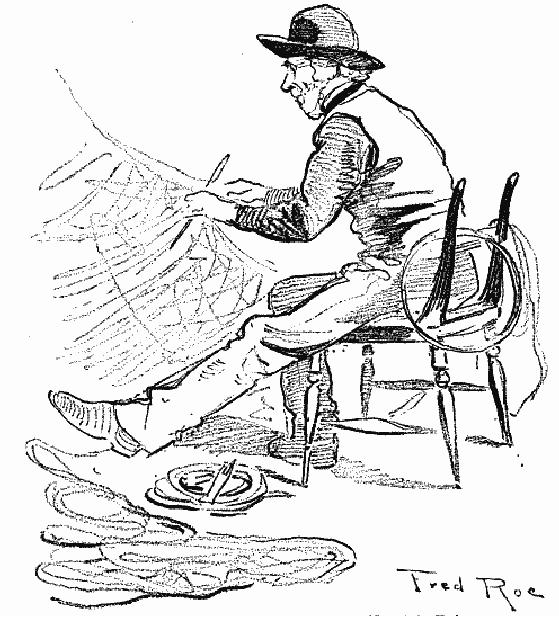
An
Ancient Maker of Nets in a
Kentish Fair
Many
other fairs have been
suppressed in recent years, but
some survive and
thrive
with
even greater vigour than
ever. Some are hiring
fairs, where you may
see young
men
with whipcord in their caps
standing in front of inns
ready to be hired by
the
farmers
who come to seek labourers.
Women and girls too come to be
hired, but
their
number decreases every year.
Such is the Abingdon fair,
which no rustic in
the
adjoining
villages ever thinks of
missing. We believe that the
Nottingham Goose
Fair,
which is attended by very large
crowds, is also a hiring fair. "Pleasure
fairs" in
several
towns and cities show no
sign of diminished popularity.
The famous St.
Giles's
Fair at Oxford is attended by thousands,
and excursion trains from
London,
Cardiff,
Reading, and other large
towns bring crowds to join
in the humours of the
gathering,
the shows covering all
the broad space between St.
Giles's Church and
George
Street. Reading Michaelmas Pleasure
Fair is always a great attraction.
The
fair-ground
is filled from end to end
with roundabouts driven by steam,
which also
plays
a hideous organ that grinds
out popular tunes, swings,
stalls, shows,
menageries,
and all "the fun of the
fair." You can see
biographs, hear phonographs,
and
a penny-in-the-slot will introduce you to
wonderful sights, and have
your
fortune
told, or shy at coco-nuts or
Aunt Sally, or witness
displays of boxing, or
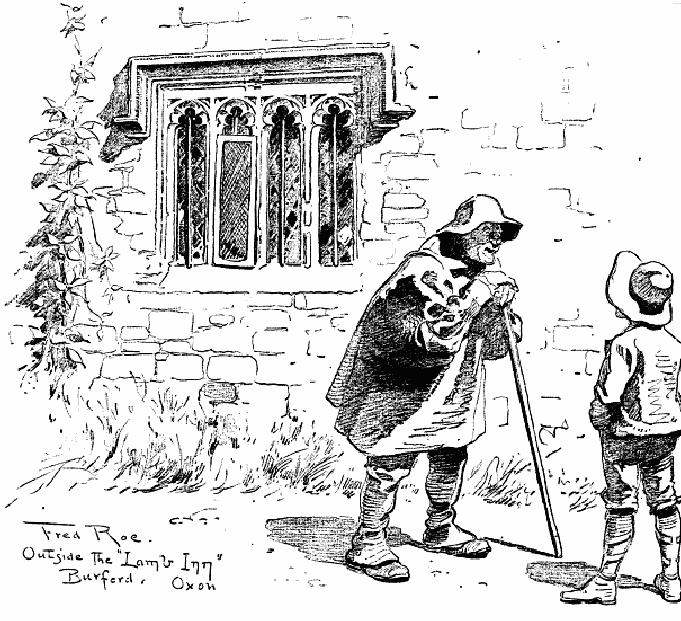
have
a photograph taken of yourself, or
watch weird melodramas, and
all for a
penny
or two. No wonder the fair
is popular.
Outside
The "Lamb Inn". Burford,
Oxon
There
is no reverence paid in these modern
gatherings to old-fashioned ways
and
ancient
picturesque customs, but in
some places these are
still observed with
punctilious
exactness. The quaint custom of
"proclaiming the fair" at
Honiton, in
Devonshire,
is observed every year, the
town having obtained the
grant of a fair
from
the lord of the manor so
long ago as 1257. The
fair still retains some of
the
picturesque
characteristics of bygone days.
The town crier, dressed in
old-world
uniform,
and carrying a pole decorated with
gay flowers and surmounted by a
large
gilt
model of a gloved hand,
publicly announces the
opening of the fair as
follows:
"Oyez!
Oyez! Oyez! The fair's
begun, the glove is up. No
man can be arrested
till
the
glove is taken down." Hot
coins are then thrown
amongst the children. The
pole
and
glove remain displayed until
the end of the fair.
Nor
have all the practical
uses of fairs vanished. On
the Berkshire downs is
the
little
village of West Ilsley;
there from time immemorial
great sheep fairs are
held,
and
flocks are brought thither
from districts far and wide.
Every year herds of
Welsh
ponies congregate at Blackwater, in Hampshire,
driven thither by
inveterate
custom.
Every year in an open field near
Cambridge the once great Stourbridge
fair
is
held, first granted by King
John to the Hospital for
Lepers, and formerly
proclaimed
with great state by the
Vice-Chancellor of the University and
the Mayor
of
Cambridge. This was one of the
largest fairs in Europe.
Merchants of all
nations
attended
it. The booths were
planted in a cornfield, and the
circuit of the fair,
which
was
like a well-governed city,
was about three miles. All
offences committed
therein
were tried, as at other
fairs, before a special court of
pie-poudre,
the
derivation
of which word has been
much disputed, and I shall
not attempt to
conjecture
or to decide. The shops were
built in rows, having each a
name, such as
Garlick
Row, Booksellers' Row, or Cooks'
Row; there were the
cheese fair, hop
fair,
wood fair; every trade was represented,
and there were taverns,
eating-houses,
and
in later years playhouses of various
descriptions. As late as the
eighteenth
century
it is said that one hundred
thousand pounds' worth of
woollen goods were
sold
in a week in one row alone.
But the glories of
Stourbridge fair have
all
departed,
and it is only a ghost now
of its former
greatness.
The
Stow Green pleasure fair, in
Lincolnshire, which has been
held annually for
upwards
of eight hundred years,
having been established in the
reign of Henry III,
has
practically ceased to exist.
Held on an isolated common
two miles from
Billingborough,
it was formerly one of the largest
fairs in England for
merchandise,
and
originally lasted for three
weeks. Now it is limited to
two days, and when it
opened
last year there were
but few attractions.
Fairs
have enriched our language
with at least one word. There is a
fair at Ely
founded
in connexion with the abbey
built by St. Etheldreda, and
at this fair a
famous
"fairing" was "St. Audrey's
laces." St. Audrey, or
Etheldreda, in the days of
her
youthful vanity was very
fond of wearing necklaces and
jewels. "St. Audrey's
laces"
became corrupted into
"Tawdry laces"; hence the
adjective has come to be
applied
to all cheap and showy
pieces of female
ornament.
Trade
now finds its way by
means of other channels than
fairs. Railways and
telegrams
have changed the old methods
of conducting the commerce of
the
country.
But, as we have said, many
fairs have contrived to
survive, and unless
they
degenerate
into a scandal and a nuisance it is well
that they should be
continued.
Education
and the increasing sobriety
of the nation may deprive
them of their more
objectionable
features, and it would be a pity to
prevent the rustic from
having
some
amusements which do not often
fall to his lot, and to
forbid him from
enjoying
once a year "all the fun of
the fair."
Table of Contents:
- INTRODUCTION
- THE DISAPPEARANCE OF ENGLAND
- OLD WALLED TOWNS
- IN STREETS AND LANES
- OLD CASTLES
- VANISHING OR VANISHED CHURCHES
- OLD MANSIONS
- THE DESTRUCTION OF PREHISTORIC REMAINS
- CATHEDRAL CITIES AND ABBEY TOWNS
- OLD INNS
- OLD MUNICIPAL BUILDINGS
- OLD CROSSES
- STOCKS AND WHIPPING-POSTS
- OLD BRIDGES
- OLD HOSPITALS AND ALMSHOUSES
- VANISHING FAIRS
- THE DISAPPEARANCE OF OLD DOCUMENTS
- OLD CUSTOMS THAT ARE VANISHING
- THE VANISHING OF ENGLISH SCENERY
- CONCLUSION